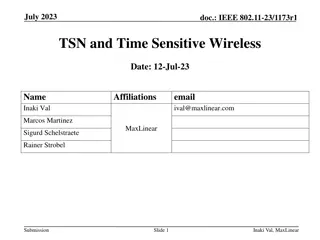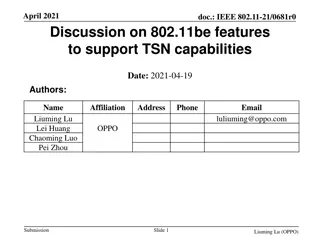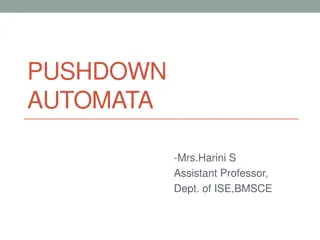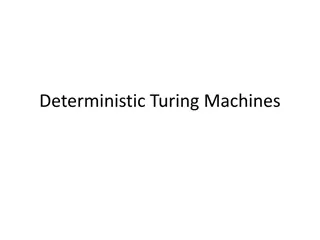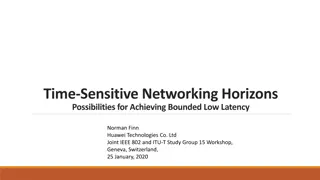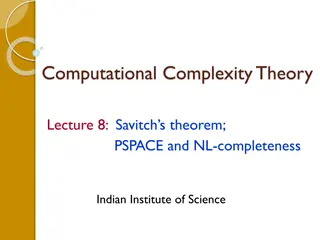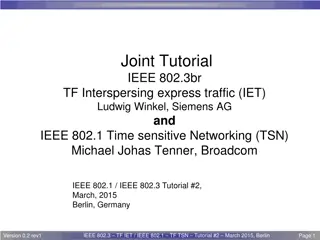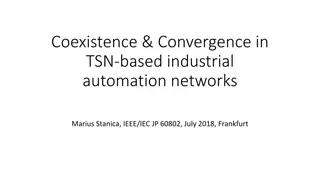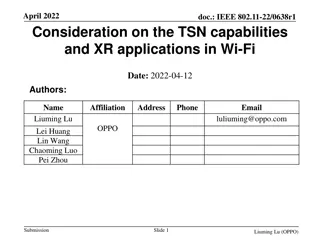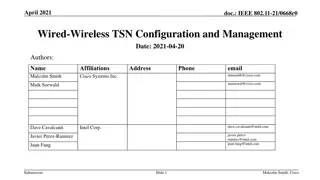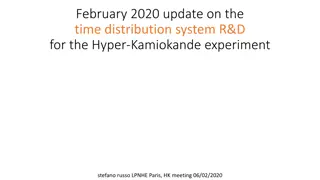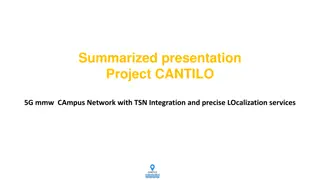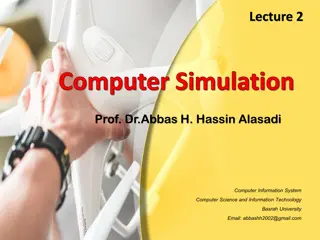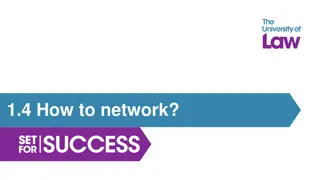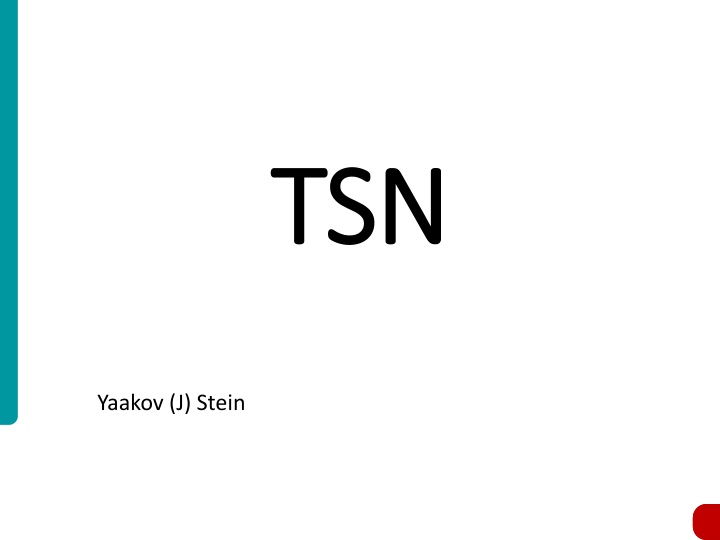
Time-Sensitive Networking (TSN) and Deterministic Networking
Time-Sensitive Networking (TSN) and Deterministic Networking (DetNet) technologies enable low-latency, guaranteed packet propagation, time-aware scheduling, high reliability, and seamless redundancy for critical applications in various sectors such as industrial automation, communication systems, and infrastructure control. These advanced networking solutions cater to the requirements of modern digital environments by providing precise timing, synchronized actions, and efficient data flows. TSN and DetNet technologies are key enablers for mission-critical applications that demand deterministic or time-sensitive handling of data streams.
Download Presentation

Please find below an Image/Link to download the presentation.
The content on the website is provided AS IS for your information and personal use only. It may not be sold, licensed, or shared on other websites without obtaining consent from the author. If you encounter any issues during the download, it is possible that the publisher has removed the file from their server.
You are allowed to download the files provided on this website for personal or commercial use, subject to the condition that they are used lawfully. All files are the property of their respective owners.
The content on the website is provided AS IS for your information and personal use only. It may not be sold, licensed, or shared on other websites without obtaining consent from the author.
E N D
Presentation Transcript
TSN TSN Yaakov (J) Stein
Time sensitive (deterministic) flows Time sensitive (deterministic) flows Communications for some applications (see draft-ietf-detnet-use-cases) require deterministic or time-sensitive handling professional video and audio (e.g., intra-studio, broadcast, public address) critical infrastructure supervisory control (e.g., IEC 61850) building automation systems industrial M2M (e.g., 802.15.4e, 6TiSCH) vehicle to vehicle (V2V) and vehicle to infrastructure (V2I) communications cellular fronthaul and backhaul blockchain pools Common requirements high availability (> 5 nines) guaranteed message delivery rapid response times consistent response times precise timing synchronized actions human interaction Y(J)S TSN 2
5G URLLC 5G URLLC When defining the 5th generation of mobile networks ITU and 3GPP decided to define three vertical market segments enhanced Mobile Broadband (eMBB) initial deployments higher data rates and moderate latency improvement requires New Radio and larger backhaul pipes massive Machine Type Communications (mMTC) low power wide area (LPWA) technologies, including NB-IoT enhancements to Release 13/14 features Ultra Reliable Low Latency Communications (URLLC) final stage mission/life critical applications ultra-reliable low end-to-end latency requires 5G Core deployment Y(J)S TSN 3
TSN background TSN background Time Sensitive Networking (TSN) and Deterministic Networking (DetNet) are Ethernet and IP/MPLS technologies that enable: very low and guaranteed packet propagation latency time aware scheduling/queuing time coordinated forwarding frame preemption very high reliability zero congestion loss (PLR of 10-10) resource reservation seamless redundancy dynamicity flows can be removed or added w/o impacting other flows co-existence of TSN traffic with regular traffic up to 75% express traffic for applications such as IIoT, V2x, fronthaul TSN is being developed for Ethernet by a task group in IEEE 802.1 The same technologies are being developed for IP and MPLS by the DetNet WG in the IETF Y(J)S TSN 4
Why latency? Why latency? Some applications require very low latency interactive audio/video Virtual Reality / Augmented Reality mobile fronthauling algotrading critical infrastructure (e.g., teleprotection) remote jamming Some applications require deterministic latency enables synchronizing industrial devices enables synchronizing data streams (e.g., lip synching) facilitates distributed power generation translates to efficiency can be translated to zero congestion Bounded delay can be converted to deterministic delay by adding a compensation buffer Y(J)S TSN 5
Why very low PLRs? Why very low PLRs? While Internet Packet Loss Ratios can approach 1% and cellular air interface induces much worse Carrier Ethernet can give PLRs of 10-6 ! Why do we need any better than that? Example 1 : industrial failures assume that 2 consecutive packets lost to a machine in a factory may cause the machine to jam, halting production GbE may sustain 1.5 Mpps, or about 1011 packets per day so a factory with 10 operational networks handles 1012 packets per day a PLR of 10-6 under IID means a 2-packet loss ratio of 10-12 so there will be a production halt every day! Example 2 : audio-video mastering mastering an 8K (7680*4320) at 60 fps requires 3.8GBps = 2.5 Mpps a camera to storage PLR of 10-6 this means 2.5 packet losses per second! since latency rules out TCP, recording is impossible Y(J)S TSN 6
QoS QoS in 802.1 in 802.1 PCP TC 802.1 defines several QoS mechanisms Traffic Class (802.1Q-2014 Annex I) multiple queues per port and strict/WF queuing congestion notification (CNM 802.1Q 33.3) EFM OAM (802.3 clause 57) Connectivity Fault Management (802.1Q 19) and other SDOs have defined traffic conditioning mechanisms 0 background 1 best effort 2 excellent effort 3 critical application 4 video <100 ms 5 voice <10 ms 6 Internetwork control 7 control data But traditional Ethernet specifications do not directly address guaranteeing QoS for real-time traffic This led to the formation of the 802.1 Audio-Video Bridging Task Group Y(J)S TSN 7
802.1 AVB history 802.1 AVB history 2003 Metcalfe challenged the Ethernet community to address new media such as networked home entertainment July 2004 IEEE 802.3 issued a Call for Interest, relating to application of Ethernet to time sensitive consumer Audio/Video Devices time/phase sensitive applications new networking requirements created by digital media November 2005 work moved to IEEE 802.1 - Residential Ethernet SG which later became the Audio Video Task Group The AVB task group produced 4 deliverables: IEEE 802.1BA: Audio Video Bridging (AVB) Systems IEEE 802.1AS: Timing and Synchronization for Time-Sensitive Applications (PTP profile) IEEE 802.1Qat: Stream Reservation Protocol (SRP) IEEE 802.1Qav: Forwarding and Queuing for Time-Sensitive Streams (FQTSS) 2012 the AVB Task Group morphed into the TSN Task Group Y(J)S TSN 8
802.1 AVB targets / enhancements 802.1 AVB targets / enhancements AVB was tasked with enhancing 802.1 bridges to achieve: 2 ms guaranteed latency through 7 Ethernet bridges admission control (reservations) for guaranteed bandwidth precise synchronization for timestamps and media coordination < 1 s absolute synchronization between devices jitter less than 100ns, filterable down to 100ps to meet the MTIE mask for professional uncompressed video It achieved this by enhancing 802.1Q, 802.3, 802.11, in particular: traffic shaping and prioritizing (802.1Qav) admission control (MMRP and SRP, 802.1Qat) synchronization based on a profile of 1588 (802.1AS) Y(J)S TSN 9
IEEE 802.1 TSN history IEEE 802.1 TSN history During 2005-2012 the Audio Video Bridging (AVB) Task Group addressed time sensitive Ethernet for the AV market (pro and consumer) In 2012 the TG was renamed TSN to handle other use cases including industrial, infrastructure, transportation, aerospace, fronthaul TSN fundamental principles assume highly accurate synchronization of bridges (better than 1 sec) provided by the 802.1AS profile of IEEE 1588 utilize protocol for reservation of resources (buffers, BW on links) achieve bounded latency for time sensitive streams new time-based buffering/queuing mechanisms frame pre-emption achieve very low PLR (better than 10-6) zero loss due to congestion due to new queuing and shaping mechanisms seamless redundancy by 1+1 replication + elimination must support co-existence of critical and BE traffic in the same network (even when critical traffic is 75%) Y(J)S TSN 10
TSN task group in 802 TSN task group in 802 IEEE IEEE-SA Standards Board Board of Governors 802 RevCom NesCom PatCom . . . 802.1 802.3 802.11 802.15 TSN TG Maintenance TG OmniRAN TG DCB TG Security TG 802.1Qbu 802.1Qbv 802.1CB ... Y(J)S TSN 11
TSN Components TSN Components (some already in 802.1Q (some already in 802.1Q- -2018) 2018) Latency 802.1Qav (clause 34) Forwarding and Queuing Enhancements 802.1Qbu, 802.3br Frame preemption 802.1Qbv Scheduled traffic 802.1Qch (Annex Q) Cyclic queuing and forwarding 802.1Qcr Asynchronous shaping Reliability 802.1CB (standalone) Frame Replication and Elimination 802.1Qca Path control and Reservation 802.1Qci Per-stream filtering and policing 802.1AX-rev LAG revision Resource Management 802.1Qat (clauses 34, 35) Stream reservation protocol (SRP) 802.1Qcc SRP enhancements and performance improvements 802.1Qcw Yang data models for Qbv, Qbu, and Qci 802.1CS Link local reservation protocol Misc 802.1AS Timing (including 1588 profile) 802.1CM TSN for mobile fronthaul IEEE 1722 Layer 2 Transport Protocol for TSN Y(J)S TSN 12
TSN latest status TSN latest status Project Subject Current stage Draft # 802.1Qbu 802.1Qbv 802.1Qbz 802.1Qca 802.1CB 802.1Qcc 802.1Qch 802.1AS/Cor2 Tech and editorial corrections 802.1AS-REV Time synch enhancements 802.1Qci Per Stream Filtering & Policing 802.1Qcj Auto Attach to PBB 802.1CM Profile for Fronthaul 802.1Qcp 802.1Q YANG data model 802d URN Namespace 802.1Qcr Asynchronous Traffic Shaping 802.1CS LRP (new registration protocol) 802.1Q-REV Bridges and Bridged Networks 802.1CBcv FRER YANG & MIB 802.1Qcw TSN (Qbu, Qbv, Qci) YANG Frame preemption Scheduled traffic 802.11 Bridging IS-IS Path Control and Reservation Frame Replication and Elimination SRP enhancements & performance improvements WG ballot Cyclic queueing and forwarding Published Published Approved Published Sponsor Ballot 3.1 3.1 2.4 2.1 2.8 1.5 2.2 3.0 5.0 2.0 0.2 0.7 1.1 1.2 0.1 0.1 2.0 Published Approved WG ballot Approved Editor's draft TG Ballot WG ballot Published Editor's draft Editor's draft WG ballot recirc develop PAR develop PAR Y(J)S TSN 13
IETF IETF DetNet DetNet WG WG July 2015 DetNet held a BoF session at IETF 93 proposing the formation of a WG to address multi-hop paths with deterministic properties controlled latency low packet loss ultra-low PDV high reliability deterministic flows for IPv4, IPv6, MPLS mechanisms to reserve/release resources encapsulations forwarding behaviors YANG models compatibility with TSN work October 2015 DetNet WG was chartered Y(J)S TSN 14
DetNet DetNet Drafts Drafts (Works in Progress) (Works in Progress) The DetNet WG has the following active IDs: draft-ietf-detnet-architecture DetNet Architecture draft-ietf-detnet-dp-sol-ip DetNet IP Data Plane Encapsulation draft-ietf-detnet-dp-sol-mpls DetNet MPLS Data Plane Encapsulation draft-ietf-detnet-flow-information-model DetNet Flow Information Model draft-ietf-detnet-problem-statement DetNet Problem Statement draft-ietf-detnet-security DetNet Security Considerations draft-ietf-detnet-use-cases DetNet Use Cases draft-ietf-detnet-yang DetNet Configuration YANG Model Y(J)S TSN 15
DetNet DetNet Related Drafts Related Drafts (Eo2018) draft-chen-detnet-loss-delay Packet Loss and Delay PM draft-chen-detnet-sr-based-bounded-latency SR-based Bounded Latency draft-finn-detnet-bounded-latency Bounded Latency draft-geng-detnet-info-distribution IGP-TE Extensions draft-geng-detnet-requirements-bounded-latency Large-scale DetNet delay draft-huang-detnet-single-path-pref Single-path PREF draft-jiang-detnet-ring DetNet in Ring Topologies draft-mirsky-detnet-oam DetNet OAM draft-qiang-detnet-large-scale-detnet Large-Scale DetNet scalability draft-wang-detnet-backhaul-architecture Joint Scheduling Architecture for Industrial Field/Backhaul Networks draft-xiong-detnet-qos-policy DetNet QoS Policy draft-xiong-detnet-qos-yang DetNet QoS Yang Y(J)S TSN 16
Theoretical Note Theoretical Note Much of the TSN/DetNet work is based on the Network Calculus a mathematical theory dealing with deterministic queuing such as in communications networks Network Calculus enables computation of bounds on queuing delays, buffer sizes, burstiness, etc. and then to combine them into end-to-end properties thus providing formal delay guarantees Network calculus also enables design and analysis of various mechanisms such as shapers Y(J)S TSN 17
802.1Qbu Frame preemption 802.1Qbu Frame preemption The major source of residence latency for a high priority packet is its waiting in a queue for a packet being output to complete transmission For example, assuming a 1500 B packet just started transmission the high priority packet needs to wait: 10 Mbps 1.7 msec 100 Mbps : 170 sec 1 Gbps : 17 sec 10 Gbps 1.7 sec 100 Gbps 0.17 sec and the situation will be much worse with 9K jumbo packets which are being standardized It is possible with present protocols to runt the outgoing packet but this would require its retransmission and burden switches along the path to parse and discard it A solution to this problem (not the most important element in TSN!) involves preemption, frame fragmentation, and local reassembly Y(J)S TSN 18
802.1Qbu Frame preemption 802.1Qbu Frame preemption Published in 2016 and being absorbed into 802.1Q When express frame(s) arrives and a normal frame is being transmitted the packet transmission of the normal frame is temporarily suspended the neighboring switch buffers the content received the express frame(s) are sent and forwarded the transmission of the normal frame is continued the neighboring switch reassembles the outgoing packet and forwards Optimal bandwidth utilization of background traffic for time aware shaping and low-latency communication in non-scheduled networks Y(J)S TSN 19
802.3br Interspersing Express Traffic (IET) 802.3br Interspersing Express Traffic (IET) 802.3br provides Ethernet physical layer support for frame preemption All frames are classified as either express or preemptable Frame could be preempted multiple times but no nested preemption IET support is discovered via LLDP (new TLV) Express frames have the usual preamble but a special physical start-of-frame SMD-e = 55 instead of SFD = AB Frame fragments are at least 64 bytes (multiple of 8 except last fragment) have usual preamble but special start-of-frame first fragment has SMD-Ix = 66 CC FF 33 (for frame 0 1 2 3) non-initial fragments have SDM-Cx = E1 D2 1E 2D + fragment ctr have a 0..3 fragment counter have their own (modified) FCS are not valid MAC frames for non-compliant devices 802.1Qbu 802.3br Y(J)S TSN 20
802.1 ( 802.1 (not not MEF!) Queuing MEF!) Queuing 802.1Q-1988 defined strict priority selection priority selector 802.1Qaz (absorbed into 802.1Q-2012) added weighted queues weighting priority selector 802.1Qat adds credit-based fair queuing (borrowed from RPR) transmit frames when non-negative credit credit increases when frames wait weighting priority selector 802.1Qbv adds time-sensitive queues queues are Open or Closed according to timeslots weighting priority selector Y(J)S TSN 21
802.1Qat Credit Based Queuing 802.1Qat Credit Based Queuing 802.1Qat adds credit-based fair queuing (borrowed from RPR) a Credit Based Shaper (CBS) spaces out frames to reduce bunching / bursting a frame is only transmitted when its queue has non-negative credit credit increases at rate idleSlope when frames are waiting or no frames waiting but credit is negative decreases at rate sendSlope when frames are transmitting rates are adjustable (per queue results in weighted queuing behavior) shaped queues have highest priority (higher than unshaped queues) Qat still guarantees bandwidth to the highest unshaped priority CBS is similar to burst rate shaper but with useful mathematical properties only parameter is bandwidth impact on queue of adjacent shapers = impact of 1 shaper with total BW Y(J)S TSN 22
CBS example CBS example Y(J)S TSN 23
802.1Qbv Scheduled Traffic 802.1Qbv Scheduled Traffic Published in 2015 and being absorbed into 802.1Q Qbv introduces Time Aware Traffic Shaping (Time Sensitive Queues) requires that every network element has highly accurate time (e.g., from 1588) time-gated egress CoS queues transmit one at a time based on a precise timeslot schedule implemented by circular collection of time aware gates Directly timing release of packets can support scheduled applications (e.g., process/vehicle control) provide latency and PDV guarantees completely avoid congestion return to TDM-like determinism Qbv retains credit-based shapers for non-scheduled applications Y(J)S TSN 24
Time Sensitive Queues Time Sensitive Queues In Qbv all CoS queues (not just the TSN queues) are cyclically gated so non-TSN traffic is also released in timeslots Qbv generally results in bursts of packets belonging to a stream Timeslot schedules are dynamically computed by a centralized management system that configures the network nodes using SRP Schedules are specified with up to 1 ns granularity (although implementations may be less precise) thus PDV can be reduced to about 1 ns Schedules might require guard times between TSN timeslots unless preemption is used Y(J)S TSN 25
Qbv Qbv Scheduler Scheduler Gate Schedule T 0 1 2 3 4 5 6 7 0 O C O O C O O O CoS queues 1 C O O O O O C C PCP 2 O C C C C O O O 0 1 2 3 5 4 6 7 3 O O O O C C C O gates selector N repeat Y(J)S TSN 26
802.1AS 802.1AS- -REV REV How do we synchronize all the network elements ? In general, TSN assumes that all time sensitive elements are sync ed to a PTP-synchronized clock 802.1AS (produced by AVB TG) is a profile of IEEE 1588 The new revision of 802.1AS includes enhancements: multiple synchronization domains common peer delay for multiple domains support for 802.11 Fine Timing Measurement (FTM) support for 802.1AX LAG improved scalability support for 1588 1-step improved support for long chains, rings more responsive faster GM change over reduced BMCA convergence time configure redundant paths and redundant GMs Y(J)S TSN 27
Peristaltic Queuing Peristaltic Queuing What can we do with Qbv time-gated queues? Knowing in detail each scheduled flow s behavior we could configure every NE in the entire network to be free precisely when the next scheduled packet arrives (this can be done using 802.1Qav) But there is a simpler (but less optimal) method called peristaltic queuing Y(J)S TSN 28
802.1Qci/ 802.1Qci/Qch Qch Cycling Cycling Queuing Queuing 802.1Q-2018 Annex Q (CQF, formerly called peristaltic shaping) Exploits accurate timing to provide without intricate signaling defined (nonoptimal) upper latency bound Each switch collects frames according to PCP and forwards all packets of the same traffic class in one cycle Maximum bytes allowed per clock cycle configured by SRP Y(J)S TSN 29
802.1Qat SRP 802.1Qat SRP Stream Reservation Protocol is similar to RSVP or RSVP-TE in that it reserves network resources for flows and uses a Traffic Specification (Tspec) 802.1Qatpublished in 2010, absorbed into 802.1Q-2011 SRP is used to configure all of the TSN features SRP is based on the Multiple Reservation Protocol (802.1Qak) like MVRP (Multiple VLAN Registration Protocol) and MMRP (Multiple MAC Registration Protocol) SRP specifies the required resources and enables their dynamic maintenance and facilitates registration, deregistration, and retention of resource reservation information in relevant network elements Talker Declarations are distributed along the path(s) to Listeners Listener Declarations run back and actually reserve resources Y(J)S TSN 30
802.1Qcc SRP 802.1Qcc SRP 802.1Qcc proposes enhancements to SRP as defined by Qat support for 1000s of streams configurable SR (stream reservation) classes and streams reduce chattiness reduce CPU load for handling SRP supports L2 but probably won t support L3 (DetNet) streaming (IETF has other protocols) Y(J)S TSN 31
802.1Qav FQTSS 802.1Qav FQTSS Forwarding and Queuing Enhancements for Time-Sensitive Streams Approved by AVB TG in 2009 and is now clause 35 of 802.1Q-2014 planning and admission control (CAC) based on SRP procedures for mapping priorities to traffic classes class A - latency 2 msec class B - latency 50 msec control traffic (AS and SRP) best effort traffic precise synchronization based on 802.1AS CBS shaping of streams at source based on 802.1Qat identification of non-participating devices Y(J)S TSN 32
802.1Qcr 802.1Qcr Asynchronous Traffic Shaping Asynchronous Traffic Shaping New project ATS Define an asynchronous mechanism (w/o sync ed nodes) for constant bit data rates and full-duplex links better than CBS Bounded delays/lossless for conformant flows even in presence of non-conformant flows 2 proposals - both intermediate between CBS and CQF paternoster algorithm ATS algorithm Y(J)S TSN 33
802.1CB 802.1CB Frame Replication and Elimination Frame Replication and Elimination Published in 2017 Frame Replication and Elimination for Reliability Basically a packet-by-packet 1+1 protection mechanism no failure detection needed insert stream ID and sequence number into every FRER frame frames are replicated at source duplicates are eliminated at destination Several stream identifier methods: DA + VID SA + VID DA + VID + IP SA + IP DA + DSCP + ... Several sequence number methods: new L2 sequence number tag for Ethernet frames HSR or PRP sequence numbers Ethernet PW sequence numbers Y(J)S TSN 34
Re Re- -replication replication and and Re Re- -elimination elimination But replicating at source and eliminating at destination only protects against a single network failure (except source and destination points themselves, which are out of scope) FRER allows configuring replication and elimination at intermediate nodes replicate eliminate eliminate eliminate replicate replicate Y(J)S TSN 35
FRER Reordering FRER Reordering 802.1CB does not require in-order delivery because it assumes that there are large buffers and packets can be re-ordered 802.1CB distinguishes between : intermittent flows (e.g., SCADA) time between packets > end-to-end latencies simple elimination algorithm - discard if SN isn t > last SN bulk flows (e.g., video streams) many more packets in flight on one path than another need to remember multiple SNs Y(J)S TSN 36
802.1Qca Path control and reservation 802.1Qca Path control and reservation Published in 2015 and being absorbed into 802.1Q Defines IS-IS extensions to enable the multiple paths required by 802.1CB FREF Redundancy paths are computed and distributed throughout the network Paths can be completely (explicitly) pinned or loosely pinned (only to certain points) Paths can be specified using metrics not usually used for forwarding Includes algorithms for finding multiple maximally disjoint paths according to various criteria Y(J)S TSN 37
802.1Qci Per Stream Filtering/Policing 802.1Qci Per Stream Filtering/Policing Published in 2017 Enables gating and metering (policing) on a per-stream basis called Per Stream Filtering and Policing (PSFP) in order to protect against excess bandwidth usage burst sizes faulty/malicious endpoints Operations are based on stream ID and priority filters meter ID and frame counters Flow metering should be based on MEF 10.3 dual token buckets (without envelope and rank) but with some new features Gating holds packets while metering marks, and optionally drops them egress filtering ... stream filters stream gates flow meters queuing frames Y(J)S TSN 38
802.1CM 802.1CM Time Time- -Sensitive Networking for Sensitive Networking for Fronthaul Fronthaul Published in 2018 Joint work with the CPRI Cooperation Specifies requirements for transporting time-sensitive fronthaul streams over Ethernet networks including delay and sync (with calculations) Specified for CPRI (class 1) [encapsulation not specified] and eCPRI (class 2) CPRI flows (IQ data, C&M control/management, sync) are handled as separate flows Synchronization via SyncE and ITU-T telecom profile (BC or TC) Adopts eCPRI scategories (A+, A, B, C) and specifies 2 profiles Y(J)S TSN 39
802.1CM Profiles 802.1CM Profiles Profile A use legacy Ethernet equipment strict priority Ethernet bridge IQ data with high priority traffic class C&M data with lower priority use 2000 bytes for all frames MEF 10.3 shaping Profile B assume very minimal TSN functionality is present Qbu+3br preemption enabled bridge IQ data is express traffic C&M data is preemptable 2000 bytes frames for IQ frames, flexible for others MEF 10.3 shaping Y(J)S TSN 40
Thanks for listening Thanks for listening Y(J)S TSN 41

